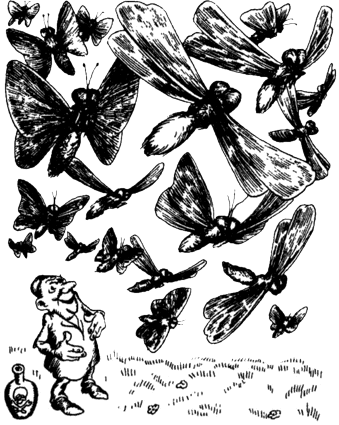107Stories About ChemistryINDEX |
105.
Chemical Warfare
Now this is a real war, though no cannon, tanks, rockets or bombs are used. It is a �quiet� war, often unnoticed by many, but a war to the death. And victory in this war spells happiness for all people. Does, say, the common gadfly do much harm? It has been calculated that the damage done in the Soviet Union alone by this noxious creature amounts to millions of rubles per year. And what about weeds? They cost the USA four thousand million dollars. Or take locusts; they are really a catastrophe, transforming flowering fields into bare, lifeless deserts. If we reckon up all the harm done to world agriculture by vegetable and animal robbery only in the course of a year, the sum is difficult even to imagine. The money would suffice to feed 200 million persons free of charge for a whole year!  There is a suffix �cide� which means killing. Now chemists have for some time been making all kinds of �cides.� They have made insecticides which kill insects, zoocides for killing rodents, and herbicides for killing weeds. All these �cides� are now used widely in agriculture. Prior to World War II mainly inorganic toxic chemicals were used. Various rodents, insects and weeds were killed with arsenic, sulphur, copper, barium, fluorine, and many other poisonous compounds. However, since the middle forties organic toxic chemicals have been finding ever wider application. This switchover to organic compounds was quite deliberate. They are not only less harmful to man and livestock, but are more universal and are required in much smaller quantities than inorganic chemicals to obtain the same effect. Only a millionth of a gram of DDT powder per square centimetre of ground area is enough to wipe out certain insects completely. There are some curious facts connected with the use of organic toxic chemicals. One of the most widely used chemicals of this class at present is hexachlorocyclohexane. But few people know that this substance was first obtained by Faraday in 1825. For more than a hundred years chemists studied hexachlorocyclohexane without even suspecting its wonderful properties. And only after 1935, when biologists began to study it, did this insecticide begin to be put out on an industrial scale. The best insecticides known today are organophosphorus compounds, such as phosphamide or M-81. Until recently external-action chemicals were used to protect plants and animals. However, it is easy to see that a good rain storm or a strong wind will wash or blow away these protective chemicals and they have to be applied all over again. And so scientists began to work on the problem of how to introduce the toxic chemicals into the organism being protected. The effect would be something like that of vaccination on man: a vaccinated person has nothing to fear from the disease he is vaccinated for As soon as the microbes get into such an organism they are destroyed by invisible �health guards� which appear in it as a result of the vaccination. It was found quite possible to prepare internal-action toxic chemicals. Scientists made use of the difference in structure of the organisms of the insect pest and the plant. Such a chemical is harmless to plants but a deathly poison to the insect. Chemistry protects plants not only from insects, but from weeds as well. Chemicals called herbicides were invented which depress weeds but practically do not interfere with the development of the cultured plant. Strange as it seems, the first herbicides were probably fertilizers. It was noted long ago by practical farmers that if increased amounts of superphosphates or potassium sulphate are applied to the fields the cultured plants grow intensively, but weed growth is depressed. Now however, as with insecticides, organic compounds have become the leading herbicides. |





